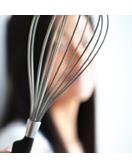Yet, there are still about a dozen of juicy lemons hanging onto our miniature lemon tree, waiting to be harvested and consumed. And so I used a couple of them to bake this perfect cottony soft lemon chiffon cake...
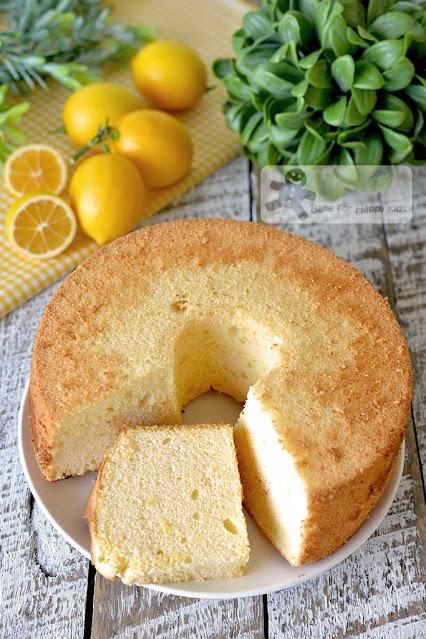
My Perfect Cottony Soft Lemon Chiffon Cake
I'm sorry that I have not been able to answer your questions at my blog, Facebook, YouTube channel and Instagram but I have been reading these questions from time to time. There are really too many questions to answer. As I'm a full-time working mum, I don't really have the time to do that.In fact, most of these questions are actually very similar, asking if my recipes can allow the substitution of one ingredient with another. I would love to reply them with a firm "YES" or "NO" but I have to say that most substitutions aren't that straightforward.For instance, I was asked by many readers if I can use My Perfect Ultra Soft Orange Chiffon Cake at HERE to bake the same Ultra Soft Lemon Chiffon Cake. Although the substitution idea seems theoretically and obviously YES, it is actually practically NO!!!Why NO? Simply because I have tried baking a very lemon chiffon cake before and saw that it didn't rise optimally as expected. Then, I realised! Orange juice is typically pH 3.5 whereas lemon juice is more acidic being pH 2-3. As we know, acid can dissolve the gluten, causing the batter to be weaker or wetter and unable to rise perfectly with fine fluffy texture.So what should we do if we want to bake a lemon chiffon cake?First, I can't over-load the cake with too much lemon juice! Thus, I shall stick to modify My Perfect Ultra Soft Orange Chiffon Cake at HERE as the cake batter yield from this recipe is suitable to bake with acidic ingredients as the cake batter won't turn out to be too wet to bake.Second, I need to boost the gluten content of this recipe because lemon juice is more acidic than orange juice. And so I substituted 80g all purpose flour and 40g corn flour with 105g all purpose flour and 15g corn flour.Third, I know that this lemon chiffon cake won't rise very well due to its extremely acidic content and so I won't bake it in lower oven temperature. Hence, the surface of the cake will still crack a little even though it didn't rise a lot while baking.
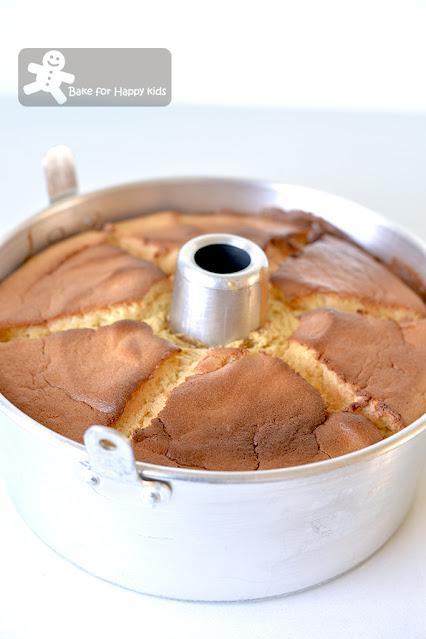
This is the ultimate lemon chiffon cake that I baked with too much lemon juice added.It didn't rise optimally as expected.
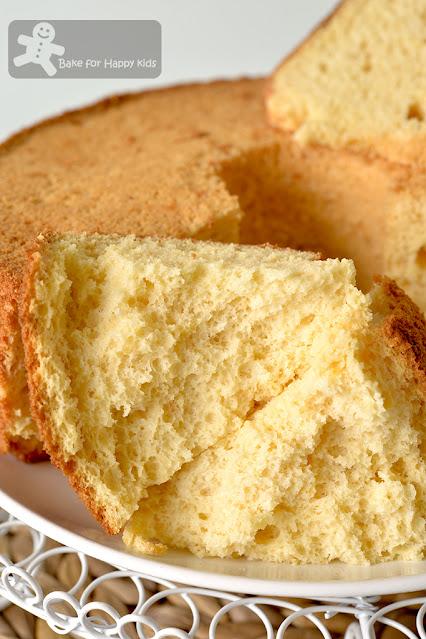
The cake was moist and lemony but the texture was not fine and cottony enough.Lesson learnt: Do not add too much lemon juice to bake a chiffon cake!
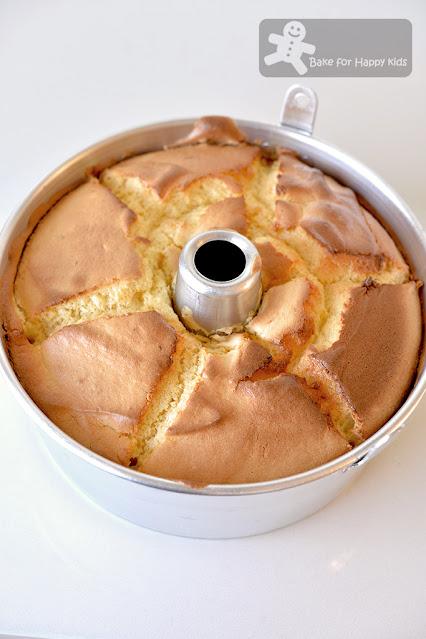
Next, I baked this lemon chiffon cake
by modifying a Perfect Ultra Soft Orange Chiffon Cake at HERE
This time, the cake rose slightly better.
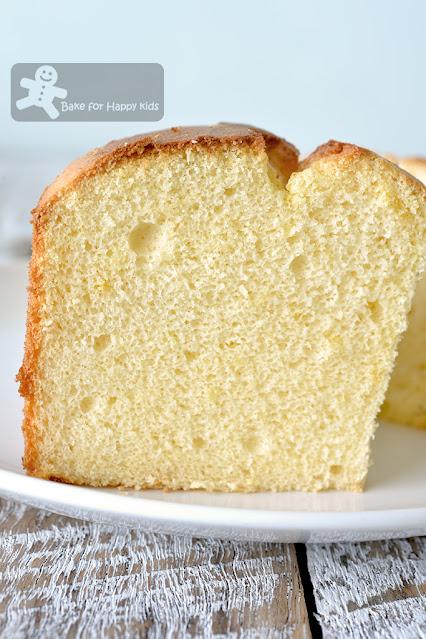
Yay! The cottony texture is near-perfect with just a few large bubbles.
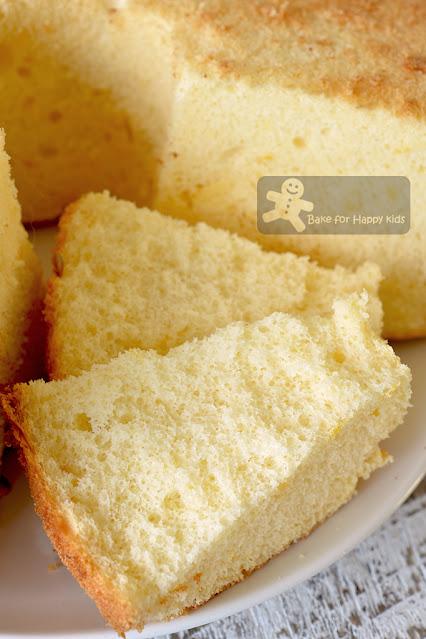
Way softer than the previous lemon chiffon cake!!!It is impressive, cottony soft and delicious!!!
This lemon chiffon cake is the most perfect version that I can bake. Although it is beautifully cottony soft, I wouldn't say that it is ultra soft because the extreme high acidic content has made the egg white a lot more firmer than other chiffon cakes that are baked with less acidic ingredients. Told ya... I'm extremely critically honest! LOL!!!
Still, it is a beautiful cake. Watch my video to see how I baked it.
If you like my recipes and baking tips, please support me and LIKE, SHARE and FOLLOW my Facebook at here or here or my Instagram @zoebakeforhappykids or SUBCRIBE my YouTube channel at here. Your LIKE, SHARE, FOLLOW and SUBSCRIBE mean a lot to me and will keep me motivated and share more of my tried-and-tested recipes in the future. Thank you! Here's the recipe.
IMPORTANT: Please use the exact weight and make sure that all ingredients are at room temperature.
Makes one tall and perfect 8-inch (20 cm) chiffon cake
For the egg yolk mixture:
90g egg yolks (about 5-6) - please use the exact weight.
45g neutral tasting vegetable oil
finely grated lemon zest from 2 lemons
90g freshly squeezed lemon juice
105g all purpose flour
15g corn flour
1/4 tsp salt
For the egg white mixture:
210g egg whites (about 6) - please use the exact weight.
100g caster sugar
Preheat oven to 160°C with top and bottom heating. Please do not use fan forced heating!
For the egg white mixture
Using an electric mixer with a whisk attachment, beat egg whites in the lowest speed for at least 10 mins to stabilise the mixture.
While the mixture is beating, prepare and whisk egg yolk mixture.
For the egg yolk mixture:
Using a hand whisk, combine egg yolks and oil in a large mixing bowl until combined and slightly pale. Whisk in lemon zest and juice. Sift in both flours and salt and whisk gently until the batter is smooth and combined. Set aside.
Back to the beating of egg white mixture:
Increase beating speed to the next higher speed. While beating, add sugar gradually. Increase beating speed to another higher speed and continue to beat until stiff peaks form. The meringue should be very smooth with tiny bubbles. Do not over-beat the mixture.
Using a hand whisk or a spatula, gently fold in the egg whites to the egg yolks mixture in 3-4 batches. It is ok to mix the 1st batch of egg white more vigorously into the egg yolk mixture but the subsequent portions must be folded in very gently. Make sure that most of the white is not visible after folding.
Pour batter into an un-greased 20 cm chiffon tube pan. Please note that the batter is firm, not runny. So you will need to spread the batter evenly and smooth the top. Then, give the pan a gentle tap.
Chiffon baking options:
Basic - Bake at 160°C for 50 mins until it is thoroughly baked. IMPORTANT: This cake has high liquid content and needs to be baked for at least 50 mins in total. Cover the top of your cake very loosely with a piece of foil when it turns brown too quickly at the last 15-20 mins of baking.
Or with slits - This chiffon cake baking strategy will help the cake to rise uniformly rising with minimal cracks. The cake will also have a deep flavoursome top and surrounding crust.
Bake at 160°C for about 10-14 mins or until a "skin" has formed on the cake surface and just before the cake surface starts to crack.
At the 10th to 14th minute, remove the cake out from oven. Cut 6 or more slits on the cake surface and place the cake back into the oven immediately. Continue to bake at 160°C for another 35-40 mins or until it is thoroughly baked. Cover the top of your cake very loosely with a piece of foil when it turns brown too quickly at the last 15-20 mins of baking. The total baking time has to be at least 50 mins.
Please do not bake this cake with too low oven temperature or a tray of boiling water (also known as steam bake). Detailed explanation is at here.
After baking, drop the cake from a 20-30 cm height immediately onto your tabletop to minimise shrinkage. Then, invert the cake immediately to cool on a wire rack. Allow the cake to cool completely in the pan before removing it from the pan. Important: Do not unmould the cake by pressing it! To unmould, please use a blunt thin plastic spatula or knife to run along the cake's edges and gently push the cake out from the pan. The cake is fragile and so it is easier to slice with a serrated knife. Enjoy!Happy BakingPlease support me and like me at Facebook...
